Satellite Imagery Analysis 2021/05/24
Shanghai Jiangnan Shipyard
Tokuhiro Ikeda (Former Maritime Self-Defense Force Commandant Kure District / Vice Admiral)
Xinhua News Agency first filed an official report on the construction of the Chinese navy’s third aircraft carrier (now known as the Type 003 aircraft carrier) in November 2018. Through a detailed analysis of satellite imagery, the U.S. Center for Strategic and International Studies (CSIS) concluded that the building of the Type-003 carrier had probably begun at the Shanghai Jiangnan Shipyard in May 2019. A new assembly facility and piers for mooring large vessels were under construction, and a structure thought to be a bow section was spotted at the assembly facility.
For the first time, Sasakawa Peace Foundation’s China Observer was able to acquire satellite images of the Jiangnan Shipyard up to October 2020. We analyzed the imagery to find out the status of the construction of the Type 003 carrier, using the CSIS study as a reference.
Below is a satellite photo of the Shanghai Jiangnan Shipyard in October 2020. After being assembled at the “new assembly facility” using the modular construction method, most of the Type 003’s modules had already been moved to the dry dock about 2 kilometers away. In the past, the Chinese navy had procured an unfinished Soviet aircraft carrier Varyag to be completed and built as China’s first aircraft carrier “Liaoning” at the Dalian Shipyard, launching this vessel in September 2012. Its second carrier “Shandong” (China’s first domestically built carrier) was also put into commission at the Dalian Shipyard in December 2019. While it is unclear why the third carrier, the Type 003, was being built not at the Dalian Shipyard but at the Shanghai Jiangnan Shipyard, the satellite images we obtained show that massive renovation work took place at great speed at the Jiangnan Shipyard for the construction of the aircraft carrier.
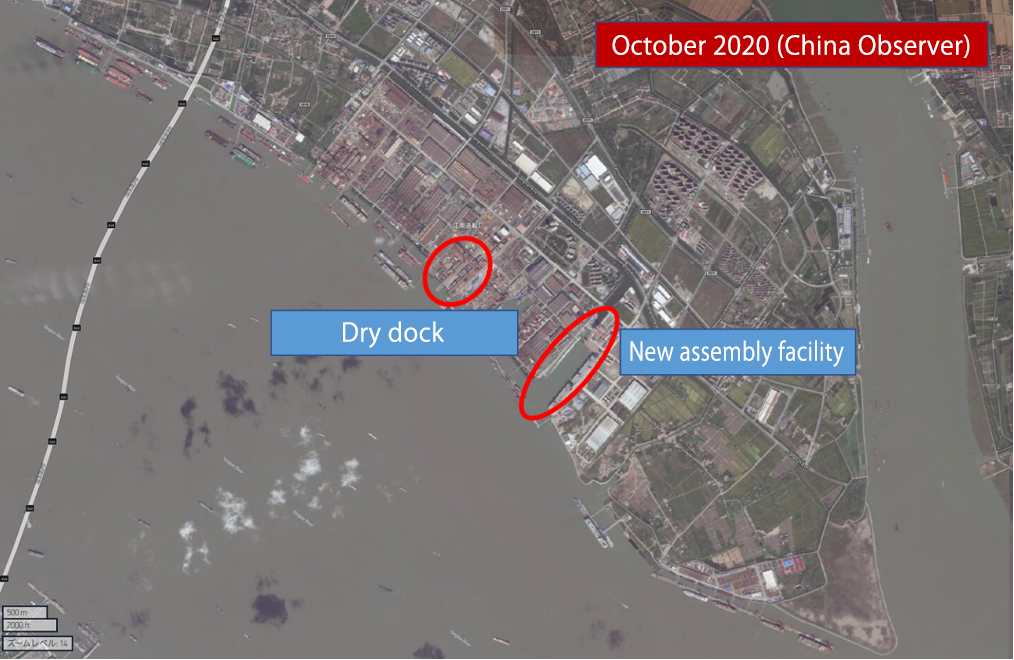
© MAXAR Technologies, Inc.
According to the CSIS’s analysis [1], the site near the “new assembly facility” for the Type 003 carrier was a marshland as of October 2018, but by August 2020, a large basin had been built.
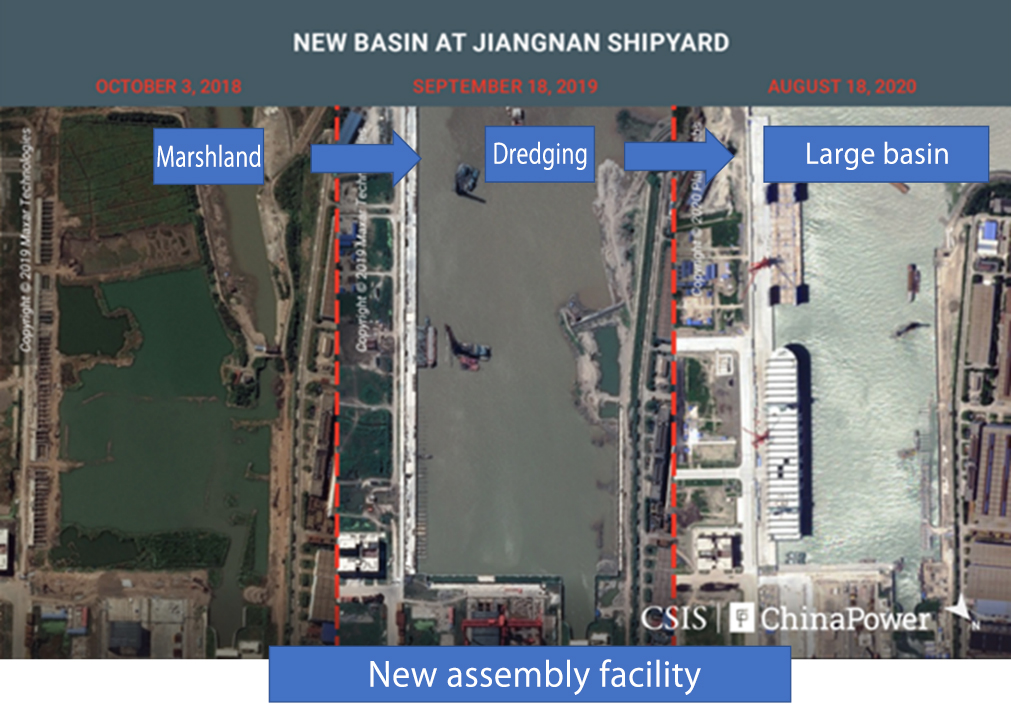
© MAXAR Technologies, Inc.
First, an analysis of the “new assembly facility.”
The satellite images obtained on the “new assembly facility” are dated March 2019, December 2019, April 2020, and the latest, October 2020.
The satellite photo below is from March 2019. A movable environmental shelter and one large and one small gantry cranes had been installed. Construction materials were placed in Lane 1 and these materials were used to build modules in Lane 2. Module-building operations took place inside the movable environmental shelter and the completed modules can be observed to have been moved outside the shelter. Lane 3 had yet to be built. Dredging operations had not been completed in the marshland.
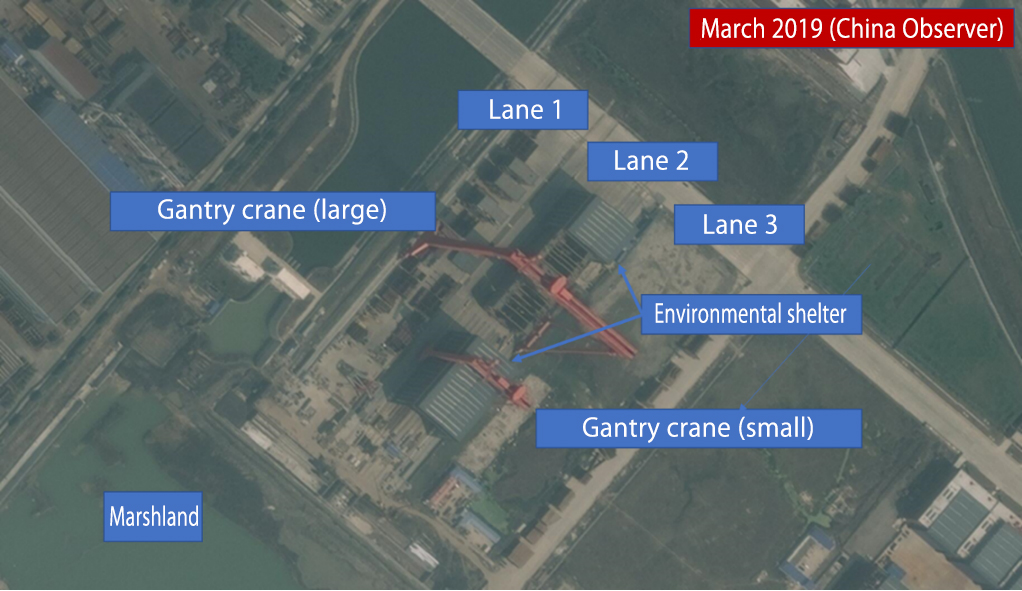
© MAXAR Technologies, Inc.
The satellite photo below is from December 2019. The main difference with the one from March is that it seems that dredging at the marshland had almost been completed and small cargo ships and barges were now moored at the new pier. Two regular cranes were set up between Lane 1 and Lane 2. They are believed to be used for loading and unloading cargo between the workboats and barges moored at the new pier and the new assembly facility. Two large trucks were also found on the side facing the road. In addition to transportation by sea, it seems that land transportation was also used.
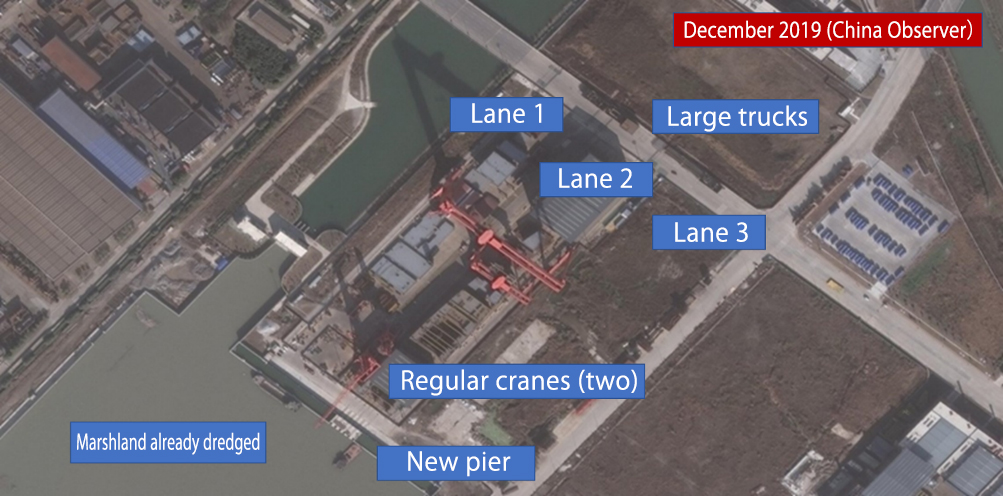
© MAXAR Technologies, Inc.
The satellite photo below is from April 2020. The two regular cranes had been removed and small cargo ships and barges could no longer be seen. Since regular cranes and barges could be found at the dredged sea area, barges were used to install cranes at the “new assembly facility” from the sea whenever needed. Compared to the photo from December 2019, the bow section can be seen more clearly. The canal side of Lane 1 was now fully built, while some land improvement at the Lane 3 site can be seen to have started. According to the CSIS’s analysis [1], the modules assembled between May 24 and June 2, 2020 had been moved to the dry dock, so the transfer of the modules in this satellite photo must have taken place right after.
The capacity of shipyards is mostly determined by the weight limit of gantry cranes and load capacity of large vehicles. Low weight limit and load capacity will require inefficient repeated transfer of each small module to the dry dock. Furthermore, the precision of construction work suffers with more frequent welding of modules hanging from cranes.
If modules the size of those at Lane 2 were moved to the dry dock on large transport vehicles, this means that the load capacity of the vehicles was considerable.
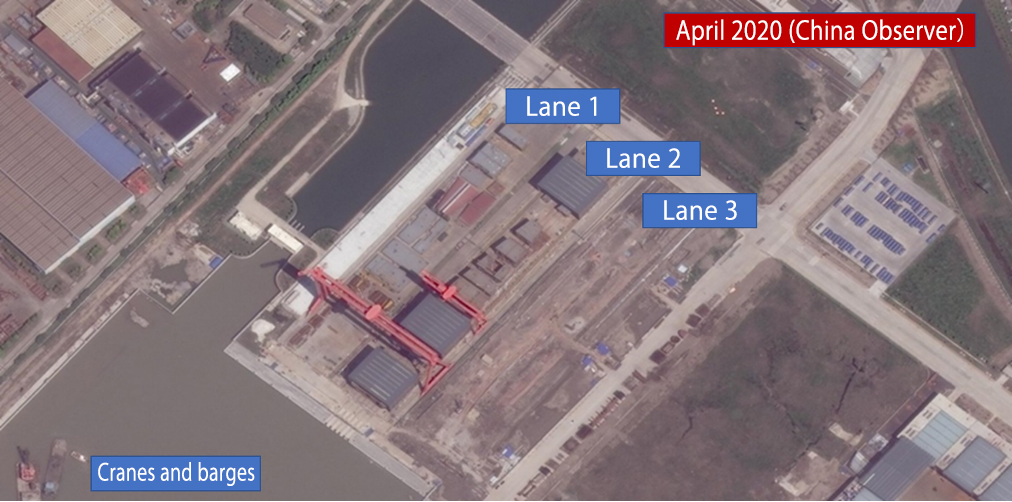
© MAXAR Technologies, Inc.
The latest satellite photo below is from October 2020. It seems that the “new assembly facility” was nearly completed. Lane 3 was already being used as an assembly facility. The environmental shelter was moved from Lane 2 to Lane 3, and the small gantry crane was also moved to Lane 3. In addition, a new basin had almost been completed at the dredged sea area, and a “new structure” was being built around this area.
A new module had been placed at Lane 2 and it would appear that assembly work was in progress inside the environmental shelter in Lane 3. A floating dock was moored near the “new pier” of the “new assembly facility.” From the above, it can be surmised that a major renovation had been undertaken on the “new assembly facility” for the construction of the Type 003. This facility consisted not only of a site on land; two piers for the mooring of 1,000-meter vessels were also built on both banks of the dredged marshland. It is reckoned that this facility and the new basin will serve as the shipyard’s core facility for the assembly, outfitting, and repair of vessels.
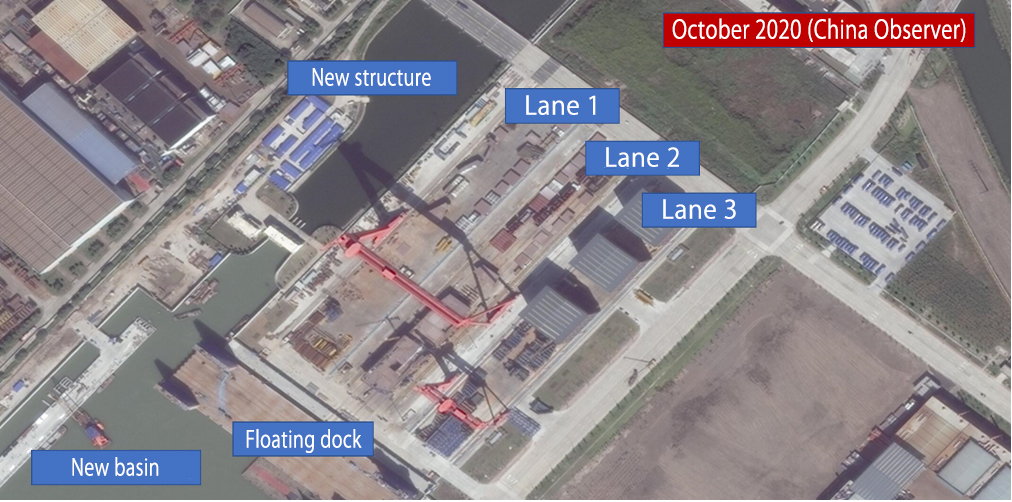
© MAXAR Technologies, Inc.
On the other hand, in terms of efficiency in shipbuilding, the plan must have been to build Lane 1 as a dry dock. If the vessel was built too fast for the dry dock to be built in time, it is possible that Lane 1 could be built as a dry dock in the future.
Normally, the gantry crane would be installed across the dry dock and the side of the dock as shown in the following diagram. (This is also the case for the dry dock where Type 003 was being built.) This way, the major precision assembly of modules (with a certain extent of outfitting) can be undertaken beside the dock and the gantry crane can slide the modules onto the dry dock for joining, thus improving efficiency and precision in the construction work.

Diagram (by this author)
Next is an analysis of the dry dock being used to build the Type 003.
The satellite photo below from October 2020 shows the positions of the “new assembly facility” and the “dry dock.” In this photo, a Type 055 guided-missile destroyer can be seen in dock behind the dry dock being used to build the Type 003.
This photo also shows that the Jiangnan Shipyard had undertaken massive facility construction for use in building large military vessels in the future. A large commercial ship was moored at the “large basin” (around 1,000 meters long) of the “new assembly facility.” The Type 003 will probably be fitted out and undergo repairs at this pier in the future.
A “floating dock” is also seen moored near the “new assembly facility.” Floating docks are efficient for ship repairs and are often used for such purposes, but since they can be expected to be unsteady, they are not suitable for precision welding of modules, and are, therefore, not ideal as dry dock for shipbuilding.
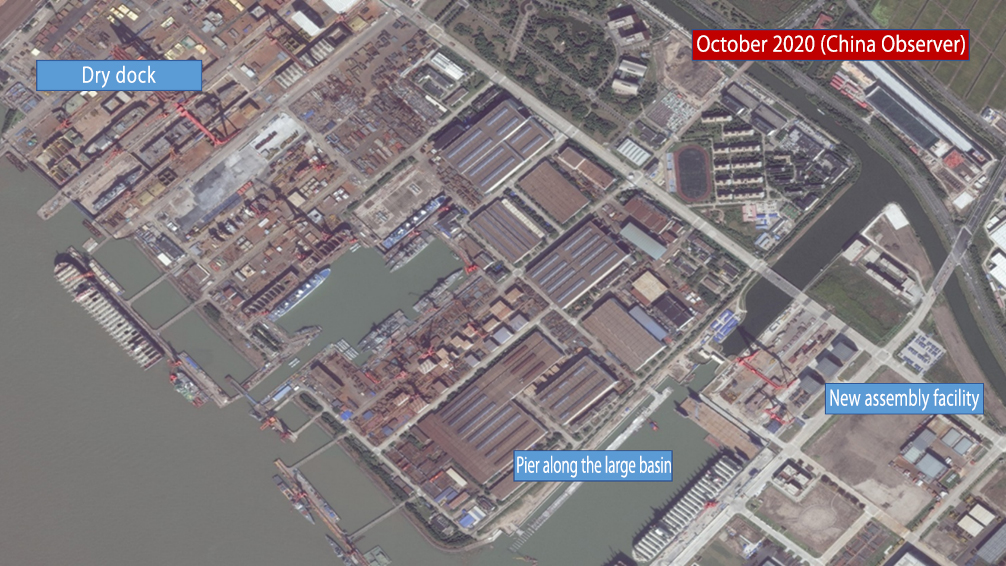
© MAXAR Technologies, Inc.
The satellite photo below shows the dry dock where the Type 003 aircraft carrier was being built in October 2020.
According to the CSIS’s analysis [1], in August 2020, nine modules of the hull were placed apart from each other. However, the present photo shows that these modules had become four modular blocks of the hull. The total length of these blocks is around 300 meters. The length of the “Liaoning,” including the flight deck, is 304.5 meters, while the “Shandong” is 315 meters long. Considering a flight deck will be added to the 300-meter hull, it can be surmised that the size of the Type 003’s hull will be about the same as the “Shandong” or even bigger. Judging from the length of the shadow, the height of the hull equivalent to the total height of all the modular blocks piled together exceeds the dry dock’s height. Since these blocks had now been piled up to around one-half the height of the shadow of the mast of the Type 055 guided-missile destroyer moored behind, it is reckoned that the assembly of the hull modular blocks was expected to be completed soon.
The above satellite photo of the “new assembly facility” in October 2020 reveals that new modules had already been placed at Lane 2. While the shape was similar to the rear of the Type 003 carrier, the width of the new hull modules in Lane 2 was 31 meters compared to the Type 003’s 43 meters. It is conceivable that the construction of a new vessel that is not the fourth aircraft carrier had begun. Although there is an opinion that China might have started building its fourth carrier, this is not corroborated by the satellite photo. It is necessary to continue to analyze signs of the start of the construction of the fourth carrier, the assembly of the Type 003’s flight deck, and further construction of the “new assembly facility” by monitoring changes at the Jiangnan Shipyard.
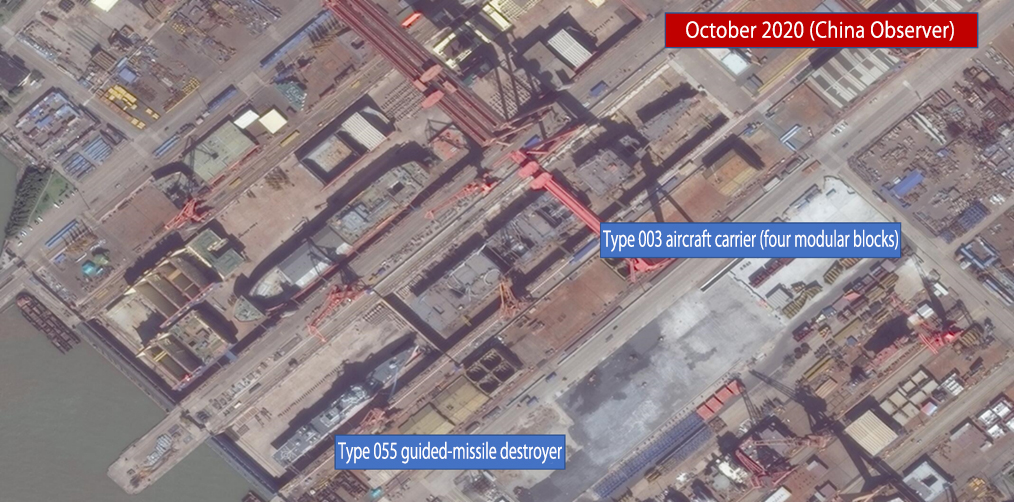
© MAXAR Technologies, Inc.
(March 17, 2021)
1 China Power : Tracking China’s Third Aircraft Carrier





